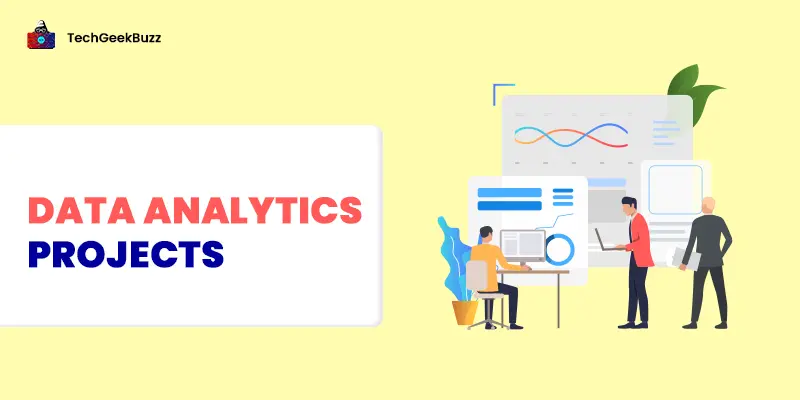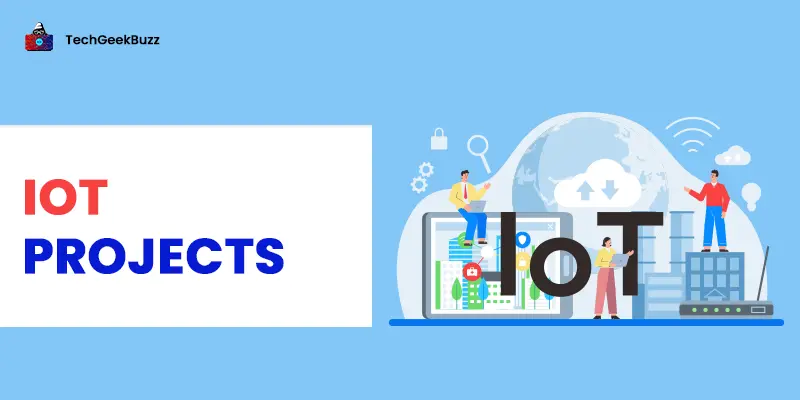Looking for some innovative ideas for your data analytics project? Look no further! With the help of this post, explore the comprehensive list of the top data analytics projects curated specially for you!
Data analytics is a vast field becoming increasingly crucial. It helps businesses perform their operations efficiently and escalate their performance. Basically, you have to interpret data and then find solutions for better growth: see what is happening, what is about to happen, and what you can do next!
Whether you are a beginner or an expert, this post will guide you with some of the most innovative data analytics projects. Take the ideas' help and pick what resonates with you the best. Additionally, each project has a list of its best features to help you make an informed decision.
Let’s begin!
What is Data Analytics - A Brief Introduction
Data analytics is the process of carefully collecting, transforming, and organizing data to make significant predictions and boost business growth. It includes data science and data engineering , too. Data analytics is a combination of a variety of subjects, like statistics, maths, computer science, etc.
There are 4 different categories under data analytics:
- Descriptive analytics : What to do with the data?
- Diagnostic analytics : Analyzing data.
- Predictive analytics : What is predicted to happen with the data in the future?
- Prescriptive analytics : What actions can be taken to improve data quality?
Moreover, professionals in this field receive competitive salaries, as organizations offer lucrative packages to experts. According to statistics, the average data analyst’s salary per year is $70,365 .
Gain detailed insights into the salary: Data Analyst Salary
Is Working on Data Analytics Projects Worth it?
Data analytics projects use computational techniques and methods to understand small or large datasets. The projects require different skills, such as machine learning algorithms , statistical techniques, data analysis , etc. Hence, individuals undertaking these projects can learn and master multiple skills from different fields.
Furthermore, building a data analytics project is a beneficial addition to your portfolio. It showcases your diverse skills and helps you grow further. You will have a competitive advantage over your counterparts and gain real-world experience.
Top 10 Data Analytics Projects You Can Work On!
Let us start with the list of data analytics projects you can consider to build and enhance your data skills.
1. Employee Productivity Analysis
The aim of this project is to focus on the employee's performance to increase the overall productivity of any organization.
Top Features
- It focuses on gathering data using project management tools and time-tracking software, employee surveys, etc.
- The key performance indicators (KPIs), like project deadlines, total work hours, leaves, and work achieved in a day, help analyze the employee’s performance. Identify the top performers with these indicators and the ones who need improvement.
- This system captures data on how employees manage their time, when they finish their allocated tasks, and whether the workload distribution is fair.
- Also, include employee feedback for better analysis of the entire team.
- Create productivity boards and performance scorecards for employees to assess their work well.
Tip: Include a system to measure productivity by continuous monitoring.
Source code: Employee Productivity Analysis
2. Quality Control in Manufacturing
This project aims to ensure the enforcement of multiple quality control processes in a manufacturing environment. It identifies any potential defects or errors in the development stage so you can improve accordingly.
Top Features
- Collect data with the help of sensors, inspection reports, and production machinery. Here, you can check for any probable defect counts. Using data analytics techniques like SPC (statistical process control) to detect defects accurately.
- Carry out root cause analysis and include key metrics such as defects, requirement of rework, etc. This way, you can assess the manufacturing process.
- Analyze the data while importing materials to ensure product quality in the long run.
- Include dashboards highlighting the real-time insights of your key performance indicators.
- Use data analytics to determine the maintenance predictions when the machinery or tool needs a quality check or improvement.
Tip: Use alerts whenever any metrics or a product quality breaches a certain acceptable limit.
Source code: Quality Control in Manufacturing
3. Weather Forecasting
With the use of data analytics, you can create a simple and extremely useful weather forecasting system. It predicts the weather based on your location and has stunning features.
Top Features
- Collect data such as temperature, humidity, air pressure, and pollution levels from sources like satellites or reputed weather stations.
- To make it interesting, include data such as dew point, heat index, precipitation expectations, etc.
- Use unit conversion methods such as converting from Celsius to Fahrenheit and vice versa.
- Include maps, graphs, or charts to visually represent the weather conditions to the users. Visual representations are always preferable.
- Use statistical analysis to predict the accuracy of weather forecasts.
Tip: based on weather forecasts, add methods of crop planning or irrigation techniques for farmers.
Source code: Weather Forecasting
4. Sentiment Analysis
This project aims to create a system that understands people’s opinions with the support of Natural Language Processing and text analysis. Using this system makes it possible to know their sentiments, positives or negatives. Such an analysis is helpful for online communities or social media profiles who wish to know the public’s opinions.
Top Features
- Ask for customer feedback and reviews to improve products or services significantly.
- Assign sentiment labels in the system like positive, negative, or neutral to better understand the opinions.
- Add multiple models and techniques to handle various languages to reach a wider audience.
- Use metrics such as F1 score, accuracy, and ROC curves.
- Include real-time sentiment analysis to monitor social media trends, customer feedback, etc.
Tip: Carry out competitor analysis to compare the sentiments of your brand against them.
Source code: Sentiment Analysis
5. Textual Data Classification
We always deal with large volumes of data. Textual data classification is a good way to assemble it easily. It helps you structure the data into labels and categories.
Top Features
- It gathers data from multiple sources such as social media channels, articles, documents, emails, etc.
- Assign labels or categories to multiple data sets to create structured content.
- Helps organize news articles or blog posts into different categories, topics, or themes.
- Recommends personalized content to users based on their interests and search intent.
- Identifies spam emails or comments.
Tip: Add a language detection feature to determine the language of any given text
Source code: Textual Data Classification
6. Customer Segmentation
This project involves segmenting an organization’s customer base into several groups based on common behaviors. By doing so, it aims to tailor to different marketing strategies and understand customers’ behavior well.
Top Features
- Use different segmentation techniques such as factor analysis or machine learning algorithms.
- Include multiple criteria to segment customers, like demographics, products purchased, frequency of purchase, etc. (include headers according to your company’s needs).
- Understand the market well and design campaigns aligning with the needs of customer segments.
- Use personalized content for each segment, like product recommendations based on their search.
- Focus on building customer profiles wherein you can monitor their needs, preferences, and behaviors.
Tip: Include feedback from all your customer interactions to make improvements and form marketing strategies accordingly.
Source code: Customer Segmentation
7. Supply Chain Optimization
This data analytics project aims to optimize the entire supply chain of a business. It includes sourcing, planning, building, and delivering the products/services. With data analytics, you boost efficiency and reduce risk in the supply chain.
Top Features
- Understand the customer demands with the help of historical data. It will help you in inventory management.
- Analyze the inventory levels and check turnover rates to know about the stock levels occasionally.
- You can check The performance of suppliers using several metrics, such as quality of the product, delivery time, cost-effectiveness, etc.
- Add features to track the transportation routes, fuel usage, and time of delivery to ensure seamless management.
- To improve customer satisfaction, focus on optimizing order processing delivery. From procurement to distribution, ensure providing them good customer service and order tracking system.
Tip: include maintenance systems to predict any risks or failures in the supply chain.
Source code: Supply chain management
8. Social Media Influence Tracking
As social media is at its peak, this is an excellent data analytics project that you can work on. It aims to collect data (likes, comments, followers, etc.) from multiple social media channels. It analyzes them so that you can improve ways to increase engagement.
Top Features
- Allow users to create individual profiles on different social media channels, including their bio.
- Monitor keywords and hashtags focusing on trending topics and subjects. This will help increase user engagement and reach a wider audience.
- Include sentiment analysis wherein the comments and likes help to understand public emotions.
- Add interactive dashboards containing charts and graphs visually representing the data (number of likes, audience engagement, demographics, best time to post, most liked and viewed posts, etc.).
Tip: Add methods to detect negative comments and crises of such kind in real-time.
Source code: Social Media Influence Tracking
9. Inventory Demand Forecasting
Every business has to maintain an inventory of the product or services. This project aims to provide inventory demand forecasting for excellent management of your business.
Top Features
- The system gathers your historical sales data and understands order history to analyze the best ways to handle the inventory.
- Create categories for data such as product type, expiry date, number of orders, order tracking feature, etc.
- Using machine learning algorithms, such as XGBoost, to know about the demand prediction. Include factors such as seasonality, economic factors, or market campaigns.
- You can also add real-time data integration with e-commerce platforms to know about forecasts when new sales data is available.
- Work with heat maps and visualization boards to monitor demand trends continuously. You can also use metrics like Mean Absolute Error, Root Mean Square Error, etc.
Tip: Use time series forecasting methods like ARIMA (AutoRegressive Integrated Moving Average).
Source code: Inventory Demand Forecasting
10. Environmental Impact Assessment
This project focuses on understanding the potential environmental impact of any plan or policy. It will analyze the consumption of natural resources and their effect on the ecosystem.
Top Features
- Firstly, it collects the environmental data under categories, namely soil, pollution level, weather patterns, water quality, etc. It scans the requirements of your project and checks all these factors to see how much your project will impact the environment.
- Use geospatial analysis to know the potential impact of land use and natural resources.
- Use a cost-benefit analysis so it becomes easy to know the environmental impact against economic benefits.
Tip: Ensure regulatory compliance with local and national environmental regulations and standards.
Source code: Environmental impact assessment
Conclusion
Data analytics is a vast field and has a lot of potential. It is used in many industries, such as healthcare, IT, education, etc. The future in this field is bright for individuals who are looking for job opportunities. Further, if you’re already well-acquainted with data analytics, you can try out the above-mentioned projects to upgrade your skills and expertise.
It is an excellent method to gain real-world experience and also upscale your portfolio. I hope that these data analytics projects help you provide the idea that you are looking for.
Good luck!
People are also reading:





Leave a Comment on this Post